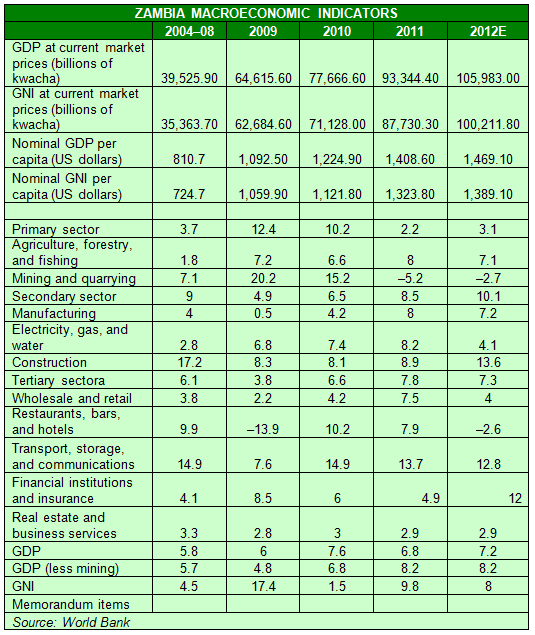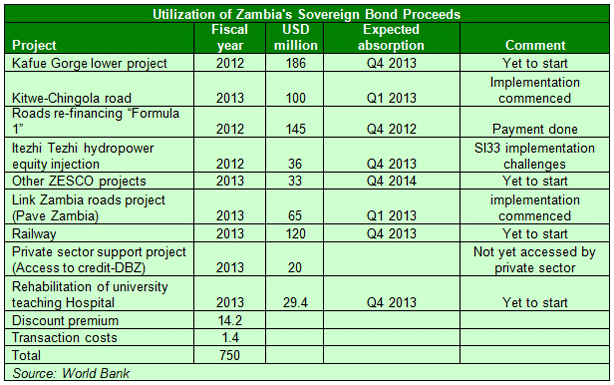Growth in Zambia is slowing as the country’s high wages and lower commodity exports to China take their toll on the economy.
The country’s GDP is projected to grow at 6% this year, compared to 7.2% in 2012, as the economy faces fiscal challenges and agriculture production contracts by about 8%.
In October, Fitch Ratings downgraded Zambia’s long-term sovereign rating to B from B+, noting that government finances have deteriorated sharply.
“The authorities expect a deficit of 8.5% of GDP in 2013, against an expected deficit at the time of the budget of 4.5% and an average of 2%-3% between 2006 and 2011,” said Carmen Altenkirch, director at Fitch Ratings.
The excess is largely on subsidies, which now account for 4% of GDP, compared to the projected 0.7% in the budget.
“This reflects perennial under-budgeting for subsidies, delays in scrapping the fuel subsidy as well as arrears payments and taking on contingent liabilities of the Food Reserve Agency. Lower-than-expected revenue also contributed towards the deterioration. In contrast, Fitch expects further spending over-runs and revenue shortfalls and predicts a deficit of 9% of GDP for 2013.”
Public sector wages have also risen 38%, while government debt will rise to 36.3% of GDP by end-2013, from 25.5% in 2011.
In addition, the country saw its gross international reserves fall from USD 3 billion at the end of 2012 to USD 2.5 billion by April 2013, primarily to support oil import and debt-service obligations. The Bank of Zambia has stepped in since then to stem the tide.

GROWTH, INTERRUPTED
Like Kenya and Ghana, Zambia has been one of the stars of Africa, with growth galloping ahead of expectation. GDP has roughly tripled within a decade, while per capita income has also soared from USD 810 in 2008 to USD 1,469, data shows. However, the growth has not translated into improved socio-economic indicators with average life expectancy of 56 years and 60.5% of the population living below the poverty line.
The economic development has been achieved by strong investments in infrastructure and a rush of foreign direct investment in the country, which reached USD 1 billion in Zambia’s mining sector alone in 2011 and 2012, according to World Bank estimates.
But the country is suffering from the perceptions of an uncertain policy environment.
The most recent example was restoring a 10% export tax for unprocessed metals less than a month after the government had removed the levy.
President Michael Sata ordered the government to repeal the law that removed the tax in a broadcast on state-owned ZNBC. Finance Minister Alexander Chikwanda halted export taxes on October 4, 2013 for unprocessed metals including copper, nickel, zinc, lead, silver and uranium, after mining companies complained Zambia lacked smelting capacity, according to reports.
“Persistent and even escalating perceptions of an uncertain policy environment could weaken investment, thereby reducing GDP growth,” the World Bank noted.
“Further, the risks of fiscal slips could undermine macroeconomic stability and undo some of the country’s recent hard-earned gains. Fiscal policy remains on a sustainable trajectory, but escalating recurrent and off-budget expenses must be reined in.”
Despite its advances and favorable economic prospects, Zambia still has to overcome huge challenges such as generating employment, reducing poverty and developing an economy that is not beholden to copper and natural resources.
“While rapid growth is welcome, the copper-dependent growth model has been unable to create enough productive jobs, formal or informal. The growth has also failed to make a real dent in poverty, the World Bank noted.

FAVORABLE PROSPECTS, BUT…
Fitch Ratings assumes that Zambia’s GDP growth will remain robust averaging 7%, based on the assumption that copper production will increase to 1.6 million tons per annum by 2017 from 800,000 tons currently.
However, falling copper prices from China could have severe consequences for the economy. While the country can manage a short-term dip, a long decline in copper could lead to the cancellation of some projects, further reducing government revenues.
“China now accounts for more than 40% of total exports, which largely comprise copper and cobalt. Reflecting a softening of Chinese growth, we expect Zambia’s current account deficit to continue to widen slowly to 1.7% of GDP in 2014,” noted the Institute of International Finance. “However, and despite persistent uncertainty about economic policies, FDI is likely to remain strong and more than cover any expected deficits.”
But the next wave of growth will need to focus on improving socio-economic indicators, with focus on job-creation and improved enrolment ratios in schools to lift millions of Zambians out of poverty.
That would involve cuts in subsidies, reining in public sector wages and a focus on capital spending.
“If meaningful reforms are not implemented, capital spending is likely to be cut in order to reduce the deficit,” according to the Institute of International Finance. “This would be short-sighted, however, as improving infrastructure is essential to facilitate economic diversification and to durably reach high single-digit growth rates.

 JOIN DRIVERN TAXI AS PARTNER DRIVER TODAY!
JOIN DRIVERN TAXI AS PARTNER DRIVER TODAY!












Baba, where are we going from here? This is serious.